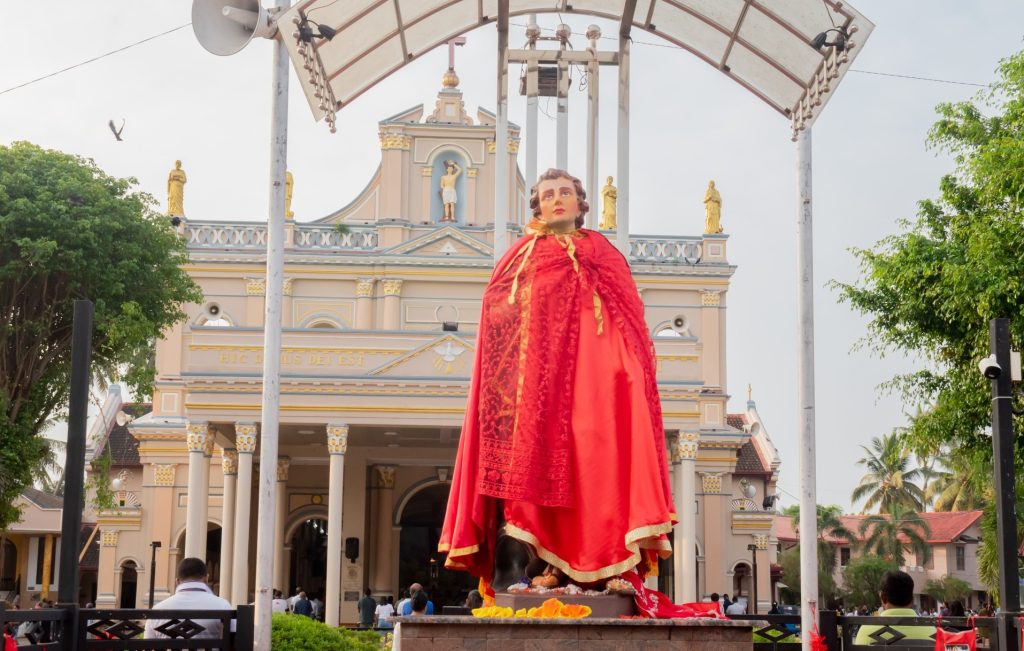St. Sebastian’s National Shrine Kandana has been consecrated as the first shrine dedicated to Saint Sebastian in Sri Lanka. St. Sebastian is undoubtedly one of the most eminent martyrs honoured and venerated by the Catholic Church. Devotees frequent the shrine in large numbers, invoking his mediation to obtain many spiritual gifts. St. Sebastian’s Shrine Kandana, through which many favours have been received over the years, has now become one of the biggest attractions for the Catholics in Sri Lanka. Kandana Palliya nestles just a kilometer from the hustle and bustle of Kandana town.
St. Sebastian’s Church Kandana welcomes people of other faiths too, as they have placed their trust in this great saint. The number of devotees who flock to St. Sebastian’s Shrine annually is rapidly increasing, and especially on the feast day of the saint, the Kandana Church premises and its precincts are fully crowded with devotees from many parts of the island. The newly constructed state-of-the-art Chapel of St. Sebastian will be an attraction in the years ahead.
St. Sebastian was a Christian saint and martyr, and according to traditional belief, he was killed during the Diocletianic persecution of Christians. Diocletian, the Roman Emperor, revealed Sebastian was a Christian, ordered him to be arrested and killed. He was initially tied to a post or tree and shot with arrows, though this did not kill him. He was rescued and healed by Irene of Rome. St. Sebastian is popularly known as the “Most Sweet Flower of Narbonne” and belongs to the class of ‘Military Martyrs’ of the early Christian Church, and his intercession is sought by many Sri Lankans.
Sebastian lived as a glorious scion, and his Christian virtues earned him many accolades. His soul was pleasing to kings in the Roman Empire, while his fearless valour pleased the God Almighty. His power to grant favours and do miracles is a well-known fact all over the world. St. Sebastian is the refuge of Catholics in times of sickness and plague and is considered the saint to whom God has granted power over all diseases. The name of St. Sebastian is invoked in almost every Catholic household with great devotion and confidence. The annual Feast of St. Sebastian Kandana is celebrated on January 20 in the most beautiful shrine dedicated to this glorious saint.
St. Sebastian’s Shrine Kandana Contact number: 0112 236 429
Related Post: St. Anne’s Shrine, Thalawila, Sri Lanka
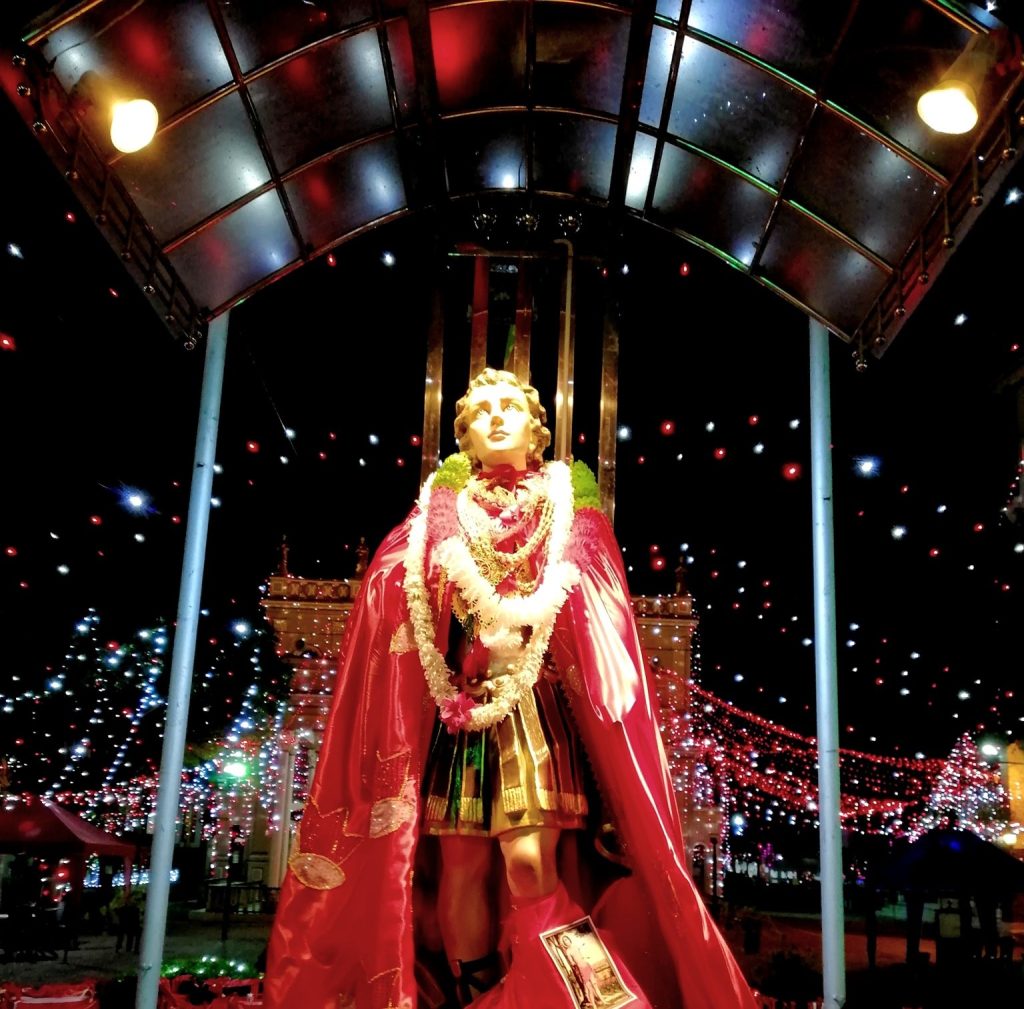
History of St. Sebastian’s National Shrine Kandana
Before the Europeans, the missioners were all Goans from South India. In the year 1834, on the 3rd of December, XVI Gregory the Pope, issued a document, Ex Muwere pastoralis ministeric, after which the Ceylon Catholic Church was made under the South Indian Cochin diocese. The Very Rev. Fr. Vincent Rosario, the Apostolic Vicar General, was appointed along with 18 Goan priests (The Oratorion Mission in Sri Lanka is a history of the Catholic Church from 1796–1874).
Rev. Fr. Joachim Alberto arrived in Sri Lanka as a missionary on March 6, 1830, when he was 31 years old, and he was appointed to look after Catholics in Aluthkuru Korale, consisting of Kandana, Mabole, Nagoda, and Ragama. There has been one church built in 1810 in Wewala, about three miles away from Kandana. Wewala Chruch was situated bordering Muthurajawela, which rose to fame for its granary. History reveals that the entire area was under paddy cultivation, and most of them were either farmers or toddy tappers. History further reveals that there was an old canal built by King Weera Parakrama Bahu. Later, it was built to flow through the Kelani River and Muthurajawela up to Negombo, which was named the Dutch Canal (RL Brohier historian).
During the British period, this canal was named the Hamilton Canal and was used to transport toddy, spices, paddy, and tree planks, of which tree planks were stored in Kandana. Therefore, the Kandana name derives from “Kandan Aana.”
Rev. Fr. Joachim Alberto purchased a small piece of land called Haamuduruwange Watte at Nadurupititya in Kandana, put up a small cadjan chapel, and placed a picture of St. Sebastian for the benefit of his small congregation. History records that in 1831, the church of St Sebastian was only a hut made of Cadjan and planks. In 1837, with the help of the devotees, he dug a small well in which water was used for drinking and bathing, and today this well is still operational. He bought several acres of land, including the present cemetery premises. Moreover, he had put up the church at Kalaeliya in honour from his patron, St. Joachim, where his body has been laid to rest according to his wish of the Last Will.
The present church was built on the property bought on August 13, 1875, on deed no. 146, attested by Graciano Fernando. Notary public of the land Gorakagahawatta Aluthkuru Korale Ragam Pattu in Kandana within the extend of ¼ acre from and out of the 16 acres. However, today only 3 acres and 16.5 perches are left according to plan number 397, surveyed by the same surveyor, while the rest have been sold to the villagers.
According to the appointment of the missionaries in the years 1866–1867 by Bishop Hillarien Sillani, Rev. Fr. Clement Pagnani OSB was sent to look after the missions in Nagoda, Ragama, Batagama, Tudella, Kandana, Kala Eliya, and Mabole. On April 18, 1866, the building of the new church commenced with a written agreement by and between Rec. Fr. Clement Pagnani and the then leaders of the Kandana Catholic Village Committee.
The present façade was then built and completed in the year 1905. The statue of St. Sebastian, which is behind the altar, has been carved from a “Madan tree.” It was done by a Paravara man named Costa Mama, who was staying with a resident named Miguel Baas of Rilualle, Kandana. This statue was made at the request of Pavistina Perera Amaratunge, mother of former Member of Parliament gate muadliyer D. Panthi Jayasuriya.
The church was completed during the time of Rev. Fr. Keegar and was blessed by the then Archbishop of Colombo, Dr. Anthony Courdert OMI, on January 20, 1912. In 1926, Rev. Fr. Romauld Fernando was appointed as the parish priest to Kandana Church. He was an educationalist and a social worker. Without any hesitation, he can be called the father of education in Kandana. He was the pioneer in building three schools in Kandana: Kandana St. Sebastian Boys School, Kandana St. Sebastian English Girls School, and Mazenod College Kandana. Later, he was appointed as the principal of the St. Sebastian Boys English School. He bought a property at Kandana, close to Ganemulla Road, and started De Mazenod College. De Mazenod College (DMC), founded in 1931, is a Catholic school in Kandana, Sri Lanka, now managed by the De La Salle Brothers.
First priest from Kandana to be ordained was Rev. Fr. William Perera in 1904. With the help of Rev. Fr. Marcelline Jayakody, he composed the famous hymn “the Vikshopa Geethaya”, the hymn of our Lady of Sorrow.
Legend reveals that in the year 1845, a South Indian Catholic on his way to meet his relatives in Colombo brought down a wooden statue of St. Sebastian, one and a half feet tall, to be sold in Sri Lanka. When he reached Kalpitiya, he had unexpectedly contracted malaria. He had thus trekked to St. Anne’s Church in Talawila and made a vow not to leave the church until he was cured. After a few days, when he felt he was cured, he left the church and started his journey to Colombo to meet his relatives, travelling in a bullock cart.
When he had reached Kandana, he came to know that in the vicinity was a church dedicated to St. Sebastian. He had hastened to the church and, showing the statue to those present there, offered to sell it for seventy-five gold coins. A resident of the area known as Elaris Amaratunga, who was the Muhuppu, joined with a few others in promptly raising the coins requested by the stranger and taking possession of the statue. In the absence of the then parish priest, Rev. Fr. Joachim Alberto, the Muhuppu of the Church, with the help of the others, had agreed to buy the statue for 75 pathagas (one pahtaga was 75 cents). The stranger, upon receiving the gold coins, was hesitant to travel to Colombo carrying the money and pleaded with the buyers to keep the money until he returned from Colombo after meeting his relatives. Records indicate that the stranger never returned to collect the gold coins.
On the 19th of January 2006, Archbishop Oswald Gomis declared St. Sebastian Church as “St. Sebastian Shrine” by way of special notification and handed over the declaration to Rev. Fr. Susith Perera, the parish priest of Kandana.
Reference: island.lk (By Godfrey Cooray)
How to reach St. Sebastian’s Shrine Kandana?
See the map below.
Who is St. Sebastian?
Saint Sebastian was born in Narbonne, southern France, and raised in Milan, Italy. Hailing from a wealthy family, he was fearless and handsome. The Roman Empire’s persecution of Christians resumed when Sebastian was an adolescent. He opted to serve under Diocletian, the Roman Emperor, and joined the Roman army in 283. He served under the co-reigning Emperors Diocletian (284–305) and Maximian (286–305). Not knowing Sebastian’s faith, Diocletian made him one of his bodyguards and intelligence officers the following year. Within a short span of time, he rose to the highest position in the Roman army and became commander-in-chief.
Emperor Diocletian declared Christians the enemies of the Roman Empire and instructed judges to punish those who had embraced the Catholic Church. Young Sebastian, as one of the servants of Christ, converted many of the other believers into Christians. However, he was a strong believer in Jesus Christ and was in the forefront of spreading the good news. At a time when the Romans were pagans and were dead against the teachings of Christ and his followers, Sebastian did not bow down to the Emperor but continued to spread Christianity, and serve and care for the sick and the poor.
Sebastian discovered that Marcus and Marcellianus, brothers imprisoned for their faith, were being pressured by their family and friends to save their lives by denying Christ. Their very own parents pleaded, teary-eyed, with their twin sons to deny Christ. Even though it was risky, Sebastian openly revealed to all at the jail that he was a Christian. He exhorted the imprisoned brothers to stay strong in the faith, even if it meant their deaths.
“O valiant warriors of Christ! Do not cast away your everlasting crowns of victory because of the tears of your relatives. Do not remove your feet from the necks of your enemies who lie prostrate before you, lest they regain their strength and attack you more fiercely than before. Raise your banner high over every earthly attachment. If those whom you see weeping knew that there is another life where there is neither sickness nor death, where there is unceasing gladness and everything is beautiful, then assuredly they would wish to enter it with you. Anyone who fears to exchange this brief earthly life for the unending joys of the heavenly kingdom is foolish indeed. For he who rejects eternity wastes the brief time of his existence, and will be delivered to everlasting torment in Hades.”
Then St. Sebastian said that if necessary, he would be willing to endure torment and death in order to show them how to give their lives for Christ. So St. Sebastian persuaded the brothers to go through with their act of martyrdom, and his speech stirred everyone present. While Sebastian was speaking, a great light, coming from heaven, surrounded him, and they saw him suddenly wrapped about in a mantle of gleaming white, with seven angels standing before him. Marcus said, “Let them tear the flesh from our bodies with cruel torments. They can kill the body, but they cannot conquer the soul, which contends for faith.”
Zoe, the wife of the jailer Nicostratus, had lost her ability to speak six years previously, and she fell down at the feet of St. Sebastian, her gestures imploring him to heal her. The saint made the Sign of the Cross over the woman, and she immediately began to speak, glorifying the Lord Jesus Christ. She said that she had seen an angel holding an open book in which everything St. Sebastian said was written. Then all who saw the miracle also came to believe in the Savior of the world.
Sebastian preached so persuasively that eventually the brothers’ parents, the jailer, sixteen other prisoners, and more than sixty other family members and friends were converted and baptized. Two of these received miraculous healings at the same time. While many of the new converts moved to the countryside for safety, Sebastian stayed in Rome to assist persecuted Christians.
The pagans arrested St. Zoe first, praying at the grave of the Apostle Peter. At the trial, she bravely confessed her faith in Christ. She was hung by her hair over the foul smoke from a great fire of dung, and then her body was thrown into the River Tiber. The priest Tranquillinus was the next to suffer. Pagans pelted him with stones at the grave of the holy apostle Peter, and his body was also thrown into the Tiber.
Saints Nicostratus, Castorius, Claudius, Victorinus, ,and Symphorian were seized at the riverbank, when they were searching for the bodies of the martyrs. They were led to the eparch, and the saints refused his command to offer sacrifice to idols. They tied stones to the necks of the martyrs and then drowned them in the sea.
The false Christian Torquatus betrayed St Tiburtius. When the saint refused to sacrifice to the idols, the judge ordered Tiburtius to walk barefoot on red-hot coals, but the Lord preserved him. Tiburtius walked through the burning coals without feeling the heat. The torturers then beheaded St. Tiburtius. Torquatus also betrayed Marcellinus, Marcus, and St. Castulus. After torture, they threw Castulus into a pit and buried him alive, but Marcellinus and Marcus had their feet nailed to the same tree stump. They stood all night in prayer, and in the morning they were stabbed with spears.
In the year 286, Emperor Diocletian discovered that Sebastian was a Christian. Thereafter, the Emperor summoned him and said, “Ingrate, I have given thee the first rank in my palace, and thou hast striven against me and my gods!” Sebastian answered: “For thee and for the State of Rome, I have always prayed to God Who is in Heaven!” Feeling betrayed, he ordered Sebastian’s death. The execution was to be public and brutal in an attempt to intimidate other Christians as well. Sebastian was arrested, tied to a post, and blindfolded. The archers stretched their bows and were ordered to fill him with as many arrows as possible. Having faith in Christ, he faced his killers fearlessly. After archers penetrating his torso and limbs with arrows, they untied him and left his pierced body dead. But Sebastian did not die!
Instead, a holy woman named Irene came at night to bury his body and found him still alive! She was the wife of Saint Castulus, an officer in Diocletian’s household, who had been martyred earlier that year. Irene carefully removed Sebastian’s arrows, took him to her home, and nursed him back to health. Though seriously wounded with arrows piercing his body, he survived. After recovering from the wounds, he continued his apostolate by spreading Christianity. Saint Irene would herself die a martyr just two years later.
Restored to health, many urged Sebastian to flee for his life. But instead, Saint Sebastian stood on the steps of the palace before the emperor, professed his faith for the second time, disclosing that he was a servant of Christ, and firmly accused Diocletian for their injustice to the Christians. And the emperors said: “Is this not Sebastian, whom we put to death with arrows?” And Sebastian retorted: “The Lord has recalled me to life, so that once more I might come to you, and reproach you for the ill you do to the servants of Christ!” His wrath on the emperor over the killings of innocent Christians angered the ruler. Shocked that Sebastian was still alive and angered by his words, Diocletian ordered the holy martyr to be taken to the Circus Maximus to be executed. This time St. Sebastian was beaten to death with clubs and thrown into a sewer, Cloaca Maxima.
But the following night, Saint Sebastian appeared in a vision of a holy woman named Saint Lucina, who revealed to her where his body was. She obeyed his request to remove his remains from the sewer and bury him in the Catacombs of Callixtus. That night, Lucina buried it in the catacombs at the entrance of the cemetery of Calixtus. Sebastian died as a martyr, but the faith he had in Christ won him a place in heaven. A basilica was built there in his memory, and it remains an important pilgrimage site today.
The Catacombs of Callixtus (also known as the Cemetery of Callixtus) is one of the Catacombs of Rome on the Appian Way, most notable for containing the Crypt of the Popes, which once contained the tombs of several popes from the 2nd to 4th centuries. The Catacombs of Rome are ancient catacombs, underground burial places in and around Rome. The Appian Way is one of the earliest and strategically most important Roman roads of the ancient republic. It connected Rome to Brindisi, in southeast Italy.
Catacombs of Callixtus
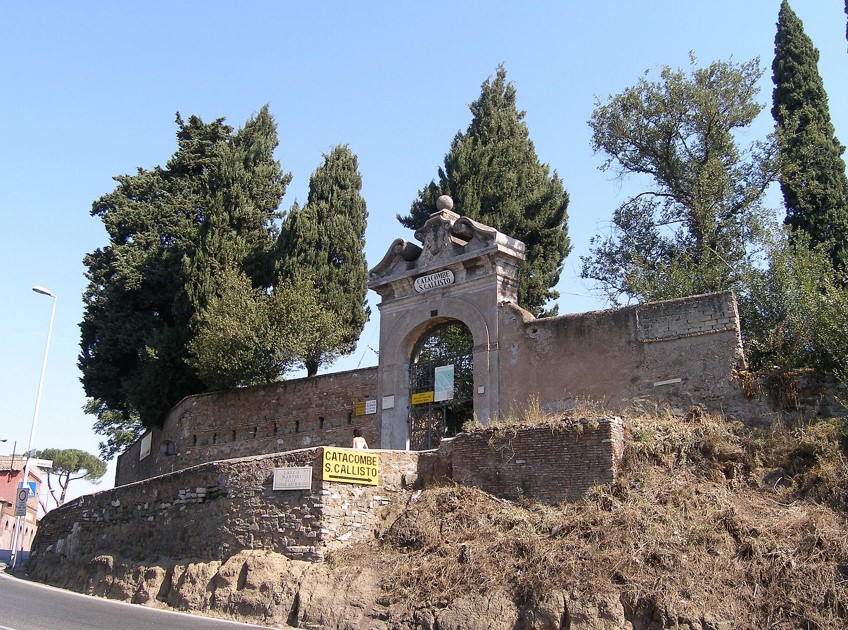
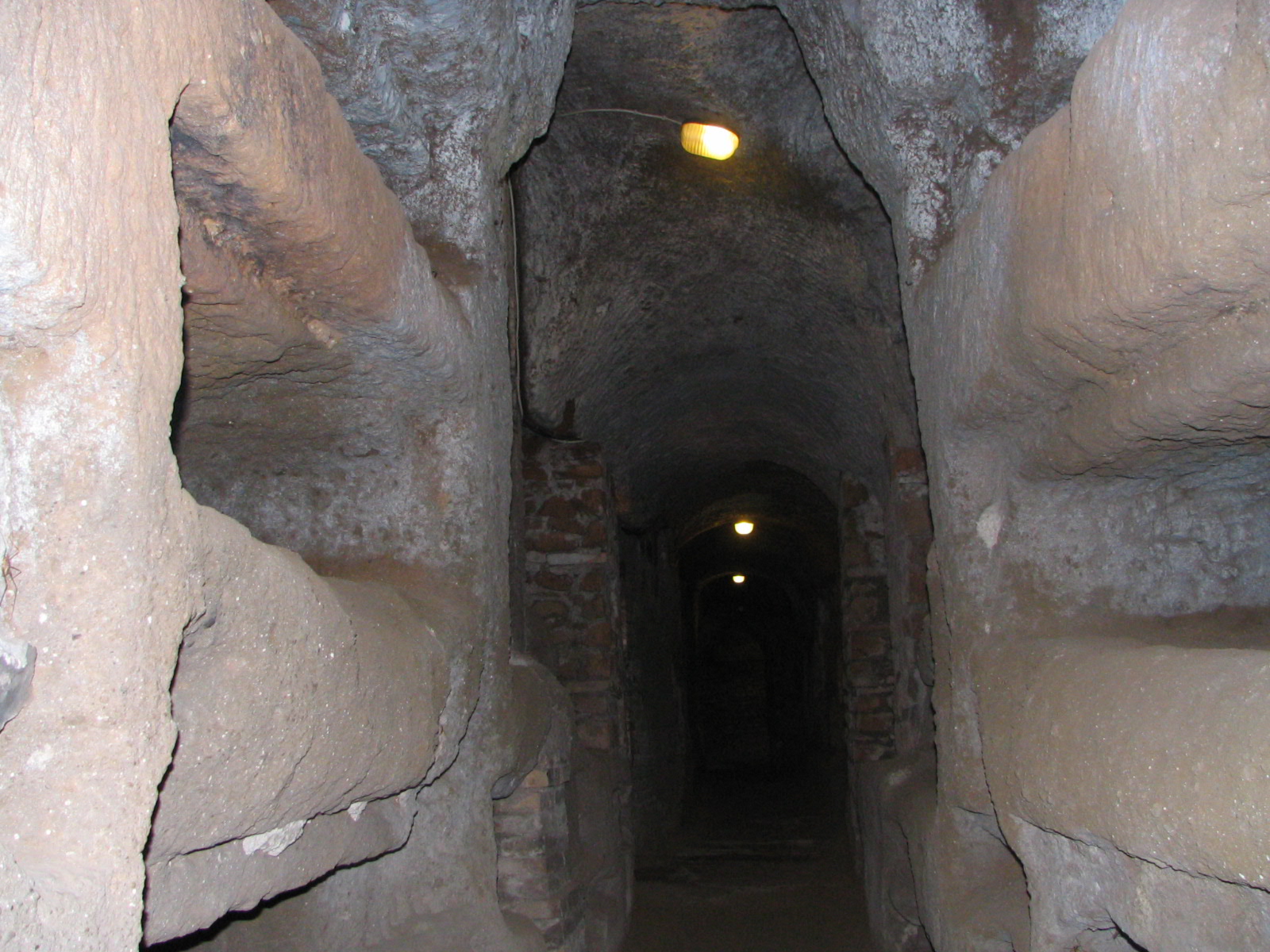
Saint Sebastian at the Catacombs
Saint Sebastian beyond the Walls or Saint Sebastian at the Catacombs, is a minor basilica in Rome, Central Italy. Built originally in the first half of the 4th century, the basilica is dedicated to St. Sebastian, a popular Roman martyr of the 3rd century. The name Saint Sebastian at the Catacombs refers to the catacombs of St Sebastian, over which the church was built Built.
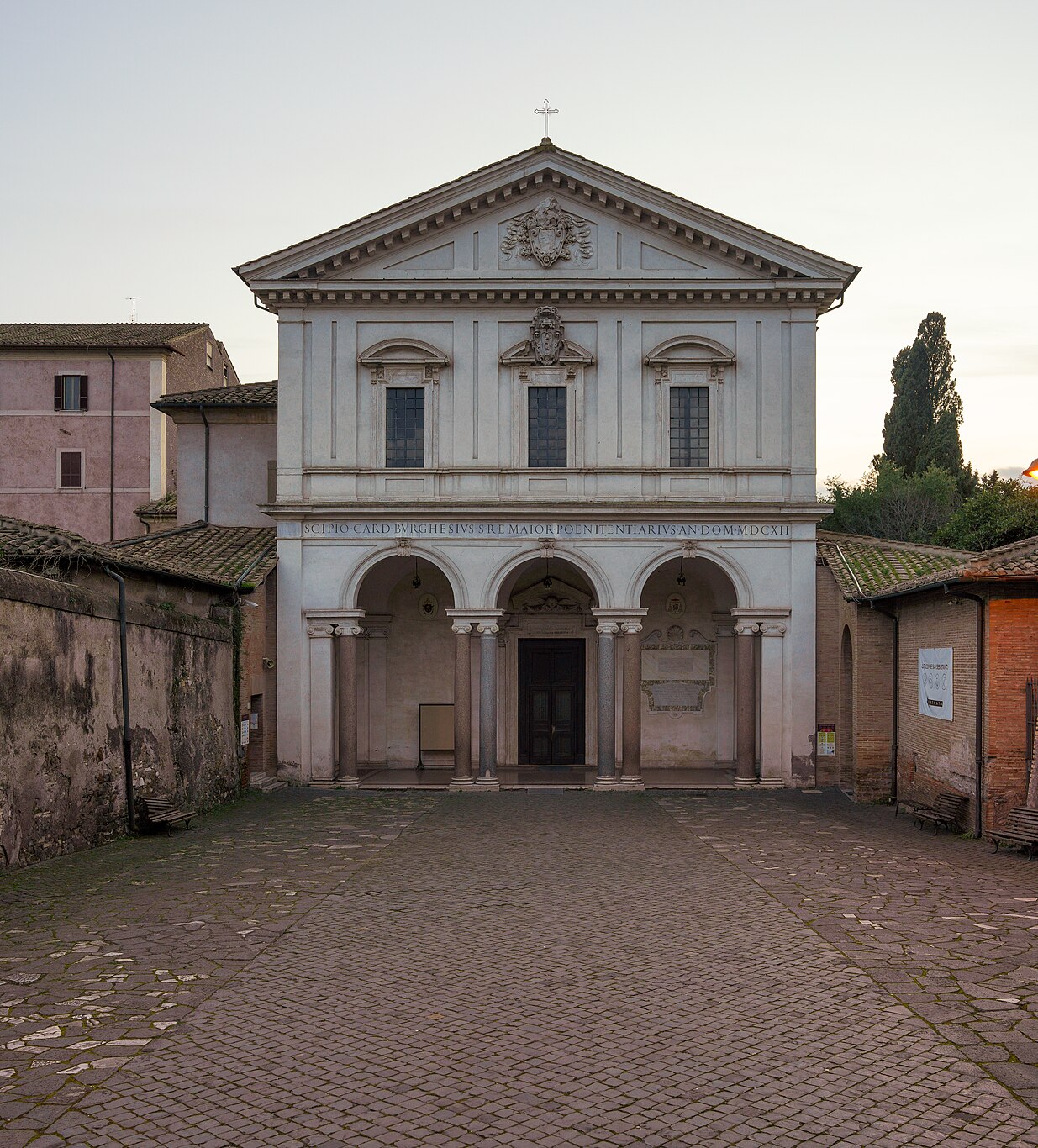
Saint Sebastian, you received the glorious crown of martyrdom twice. Your courage and fidelity to Christ in the face of persecution was unwavering. Your encouragement of the persecuted was heroic. Please pray for me, that I may have your same unwavering courage and thus equally fulfill God’s will, no matter how high the cost. Saint Sebastian, pray for me. Jesus, I trust in You.
Prayer to St. Sebastian
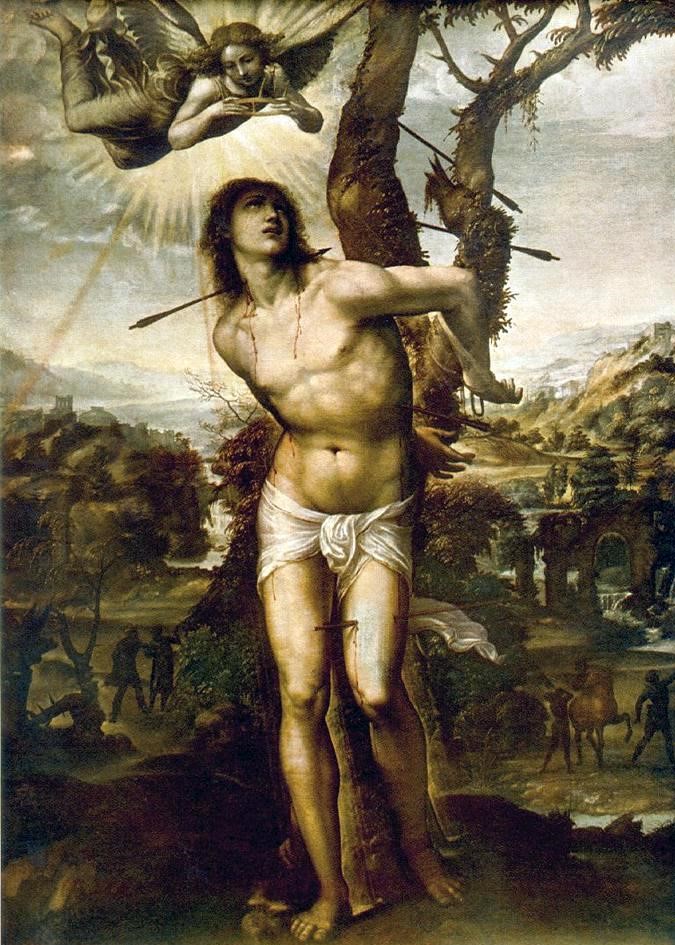
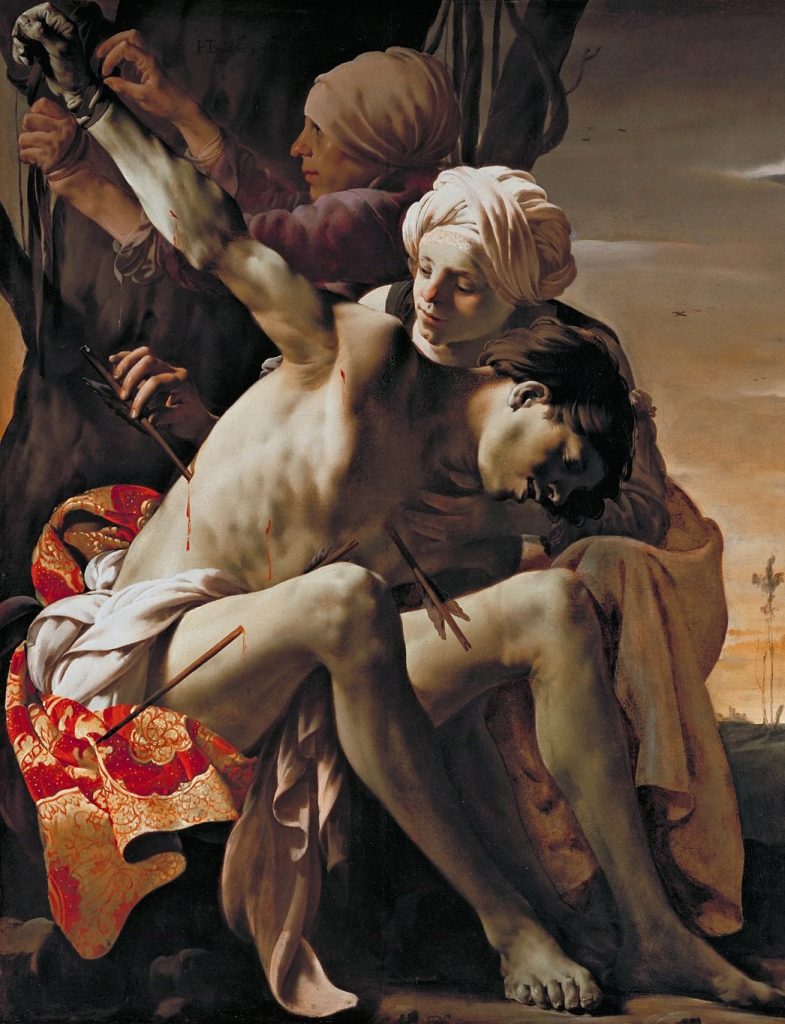
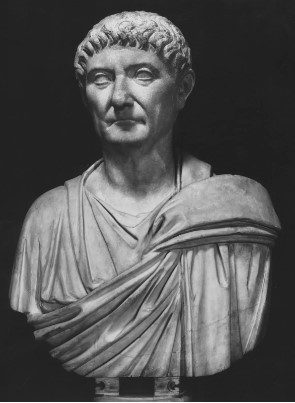
A Double Martyrdom!
The glorious crown of martyrdom was placed on the head of Saint Sebastian not once but twice.
History reveals that when Sebastian was finally discovered to be a Christian, in 286, he was handed over to the Mauretanian archers at Emperor Diocletian’s command. He was steadfast in his faith while his body was bound to a tree, pierced with a shower of arrows, and left for dead. But God raised him up.
And again, of his own accord, Sebastian went before the emperor Diocletian and conjured him to stay the persecution of the Church. This time, he was beaten to death by clubs and crowned his labors by the merit of double martyrdom.
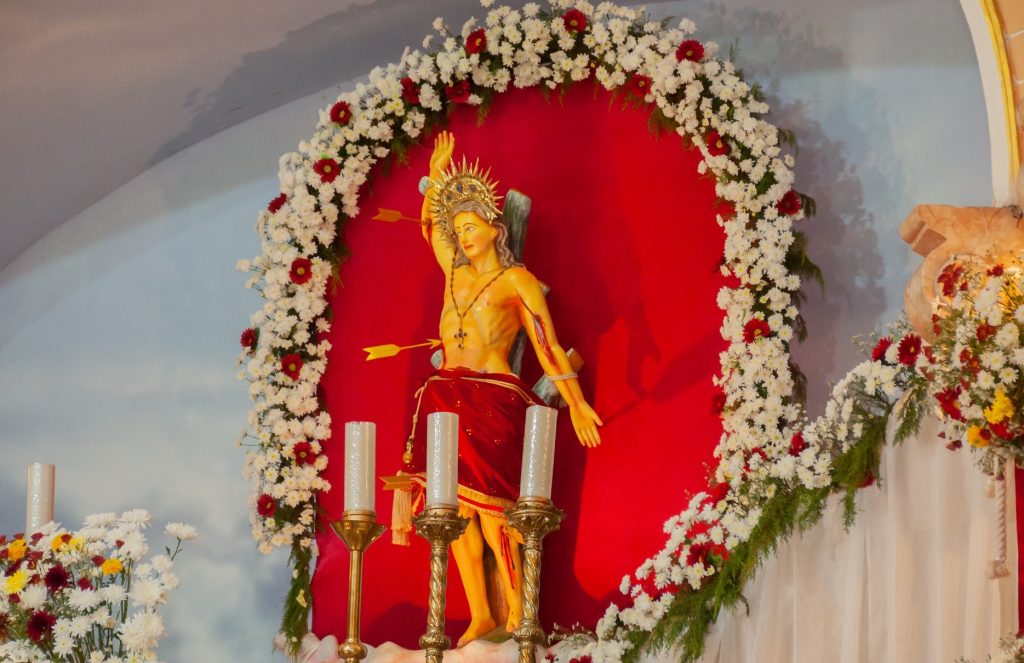
Homage to St. Sebastian (257 – 288)
Throughout the centuries, many have paid homage to St. Sebastian, and in times of highly contagious diseases, he is invoked for relief. Many churches are found in Sri Lanka, especially along the coastal belt, dedicated to this great saint, and the invocations for his blessings by devotees are ceaseless.
St. Sebastian was a brave and dedicated soldier, and it is these characteristics that have led to the various patronages associated with him. His courage in the face of death and willingness to give up his life rather than forsake the God whom he loved and served show that he was a devoted and strong man. Attributes such as these are important for athletes and soldiers, as it is their dedication and fearlessness that help them succeed in their endeavours.
St. Sebastian’s story is one of courage, dedication, and strength. Though little is known about the details of St. Sebastian’s life, the available information shows him to be a man devoted to God to the very end. Emperor Diocletian had St. Sebastian tied to a tree and shot, but the arrows that pierced his strong body failed to kill him. These arrows are still an important symbol of his sainthood.
He is the ‘Patron Saint of Soldiers’ as he entered the Roman Army to defend the confessors and martyrs of his day and for his goodness and bravery. He is the ‘Patron Saint of Athletes’ due to his physical endurance and energetic ways of spreading and defending the faith. Since he was able to endure such incredible punishment, archers are also known to pray for him in times of need.
During the 14th century, the ‘Bubonic Plague’, also known as the ‘Black Death’, ravaged through Europe, killing an estimated 75 million. At the time, the people were unaware of how the disease was transmitted and felt that catching it was a random occurrence. In an attempt to seek help from heaven, they prayed to the saint, who was associated with archery, for protection and relief from this deadly disease. This saint, of course, was St. Sebastian. He became popular as one of the ‘Holy Helpers’, because of his association with being called upon for assistance during the time of the plague.
Many countries stricken with plagues and other diseases had been protected through the intercession of St. Sebastian. In the year 680, Rome was freed from a raging pestilence under his patronage. Later, in 1575, Milan and in 1599, Lisbon, as well as many other places, experienced the effects of his intercession with God on their behalf in similar calamities. More recently, he has been honored as the patron saint of athletes because of his dogged perseverance.
After the Saints Peter and Paul, St. Sebastian is the third ‘Patron of Rome’. He is also the ‘Patron Saint of Soldiers’ as he entered the Roman Army in order to defend the confessors and martyrs of his day and for his goodness and bravery. Further, he is the ‘Patron Saint of Athletes’ due to his physical endurance and energetic ways of spreading and defending the faith.
Saint Ambrose writes of Saint Sebastian in his Preface: “The blood of the holy martyr Sebastian, which was shed in Thy name, makes manifest Thy greatness, 0 Lord, Who through his intercession workest Thy might in the weak, crownest our efforts, and givest health to the sick.”
HYMN OF PRAISE: The Holy Martyr St. Sebastian
Holy Sebastian was covered with arrows—
With a hair shirt of arrows his body was clothed.
But, beneath the arrows, his soul was unscathed;
His heart was raised to the heavens in prayer.Sebastian endured suffering for Christ.
What are mighty kingdoms, what are great riches,
Compared with this honor, compared with this illumination—
To be struck by arrows for the sake of the Living God?Wonderful Sebastian desired this:
To be crucified for the crucified Savior,
To confirm the truth by suffering and blood,
To witness the Faith before heaven and earth.The All-seeing Lord, Who sees all creation,
Measured and counted every drop of blood,
And rewarded Sebastian in the Eternal Kingdom,
Showering him with blessings without measure.O Martyr most-glorious, who suffered for Christ,
And by your suffering enlarged the Church:
Pray to God for the Church on earth,
That it become ever more beautiful, and all the more great.
Annual Feast of St. Sebastian’s Shrine Kandana
The devotion of Catholics to this church of St. Sebastian, down the years has always been so fervent, that for generations they have not failed to celebrate the annual feast. And once more, Kandana, a Catholic stronghold, filled with festivity on January 20th, when Catholics from all parts of the island flocked in their thousands in the precincts of the church to celebrate the annual feast.
In the liturgical calendar of the church, the feast of the miraculous St. Sebastian is celebrated on January 20. This day is indeed a mini-Christmas for the people of Kandana, irrespective of their religion. The feast commences with the hoisting of the flag staff on the 11th of January at 4 p.m. at the Kandana junction, along the Colombo Negombo road.
There is a long history attached to the flag hoisting in Kandana junction. The first flag staff which was an arecanut tree, 25 feet tall, was hoisted by the Aththidiya family of Kandana and today their descendants continue hoisting of the flag as a tradition. This year’s flag staff, too, was hoisted by the Raymond Aththidiya family. Several processions originating from different directions carrying flags meet at this flag staff junction. The pouring of milk on the flag staff has been a tradition in existence for a long time. Kiribath Dane in the Kandana town had been a tradition from the time immemorial.
Story behind the Flag hoisting in Kandana junction
Since the hoisting of the flag, daily novenas have been held amidst gathering of a large number of devotees of Kandana and its outskirts. The eight Novenas preceding the feast are conducted from January 11–18 at 6.30 p.m. The Vespers would be held commencing at 7:00 PM on January 19. The festive high mass would be concelebrated on January 20 at 8:00 AM, assisted by the priestly sons of Kandana. The devotion of the Catholics to this shrine over the years has always been so fervent that for generations they have not failed to celebrate the annual feast.
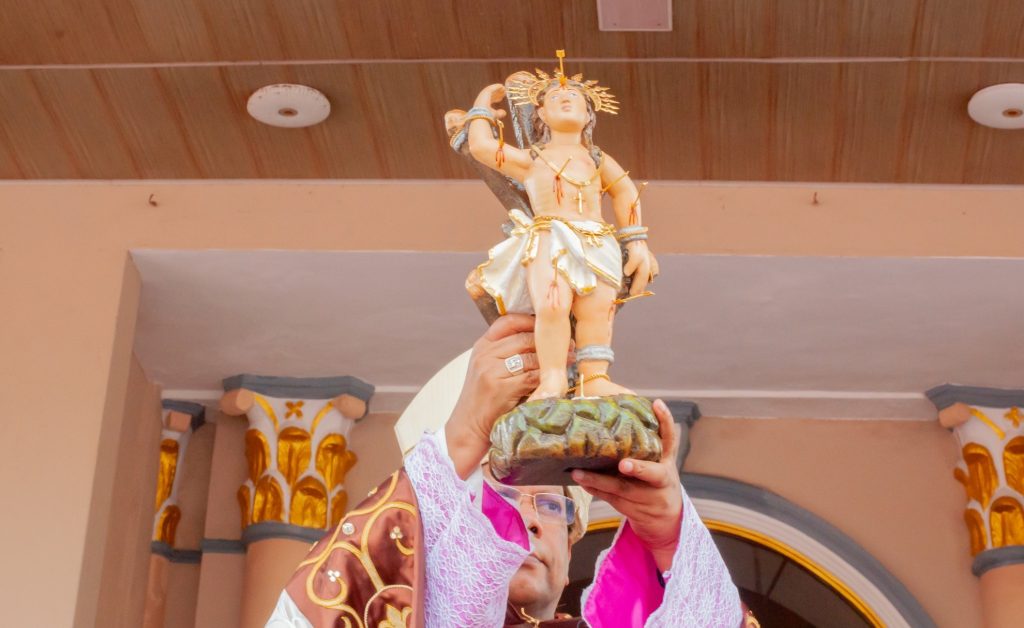
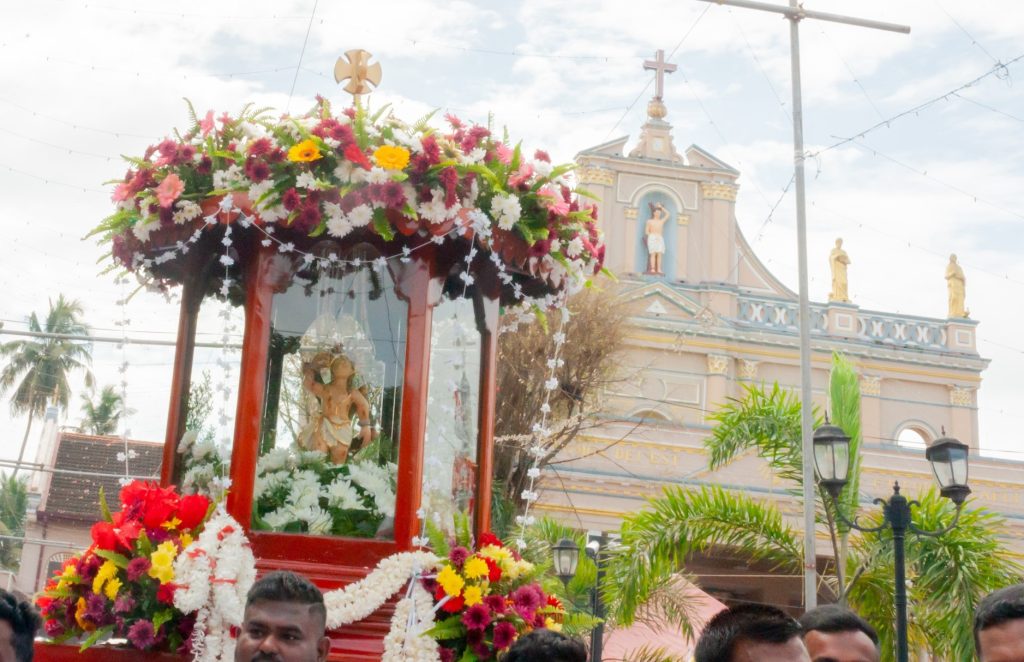
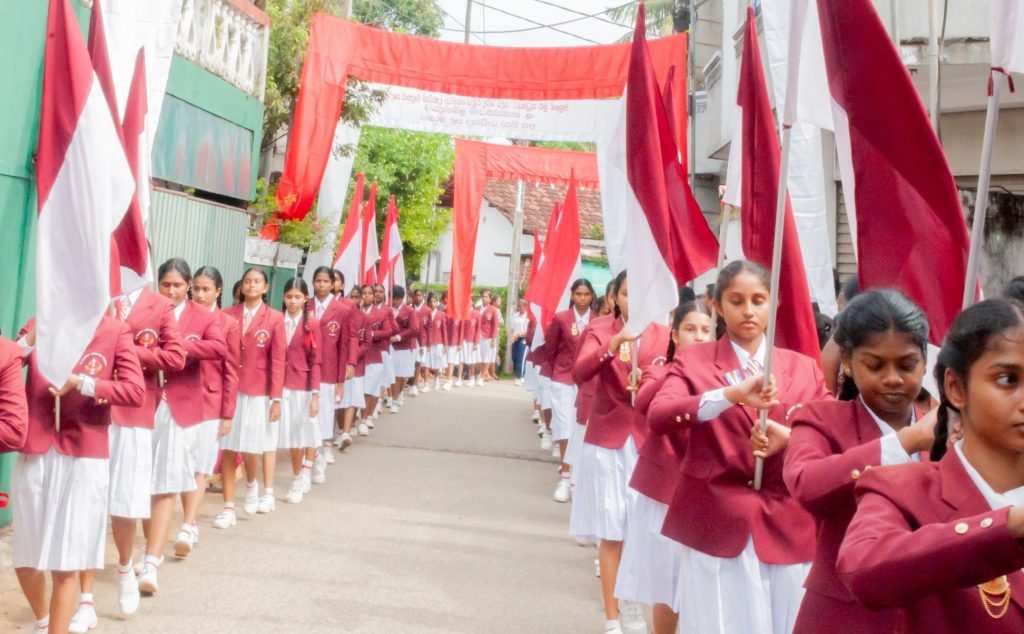
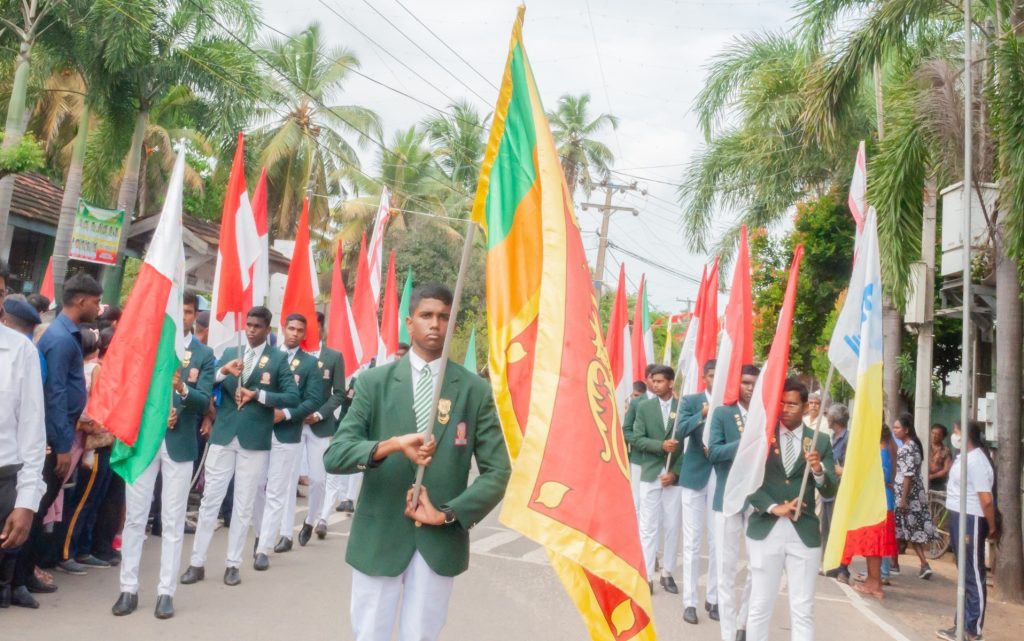
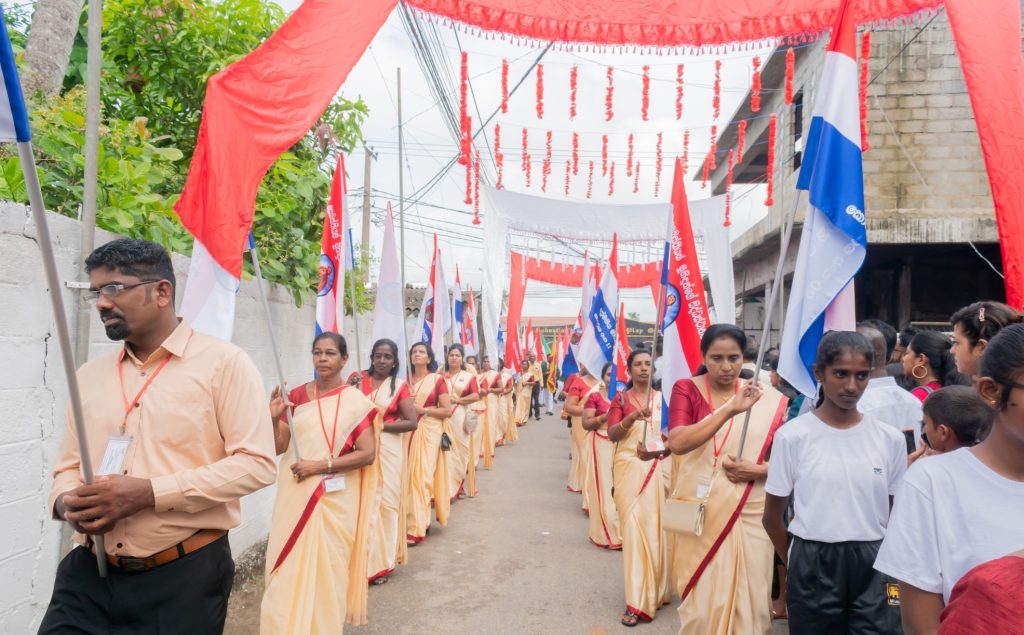
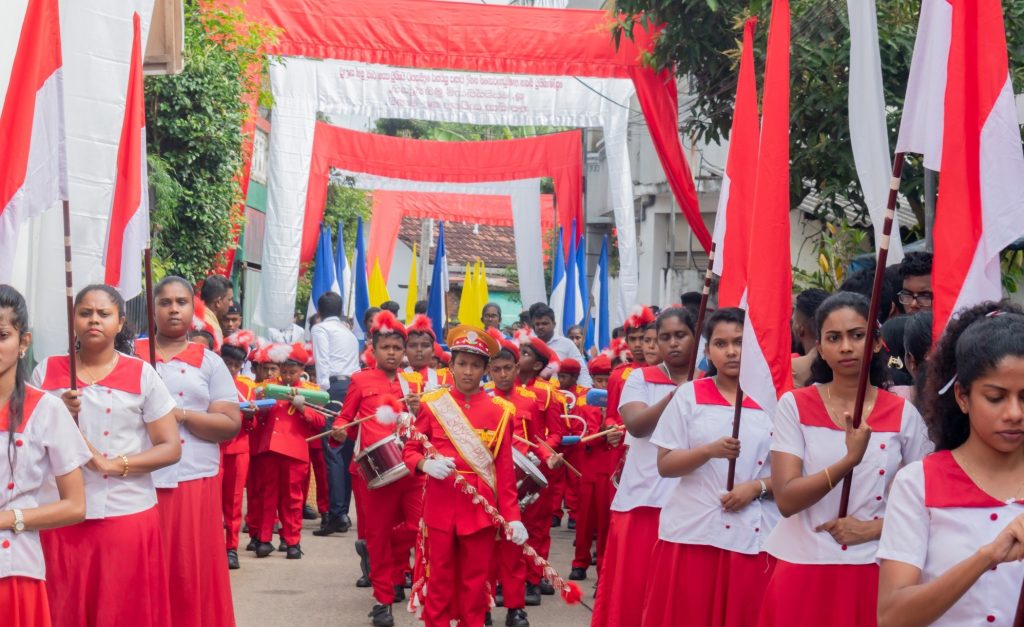
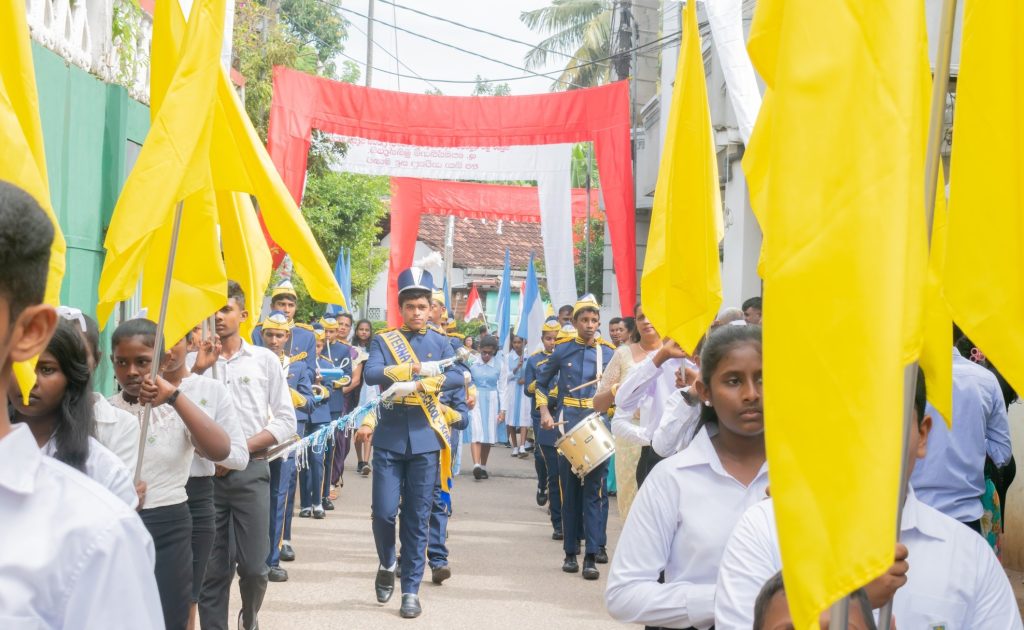
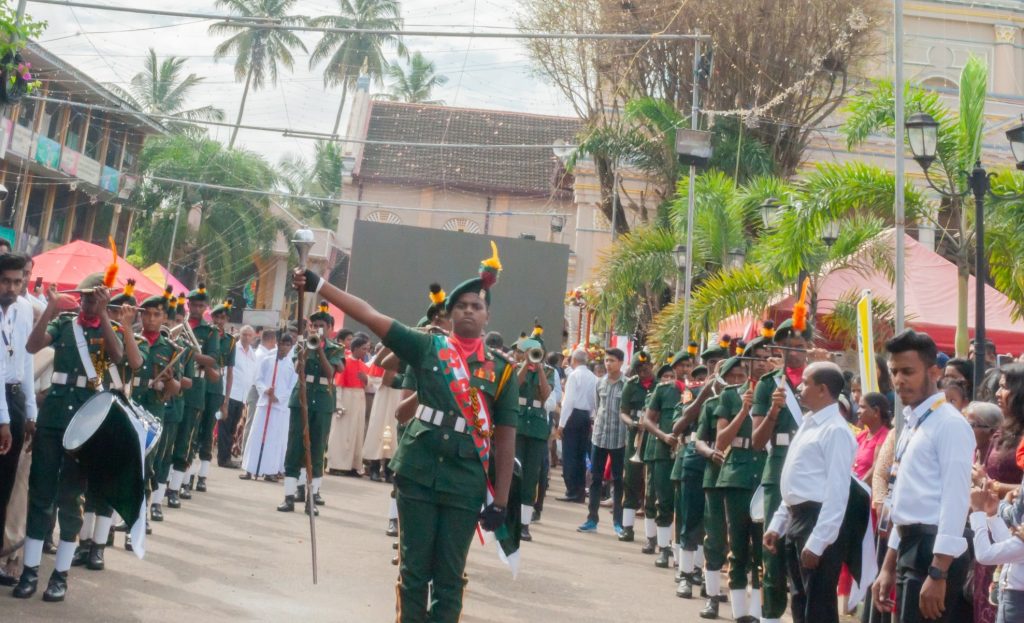
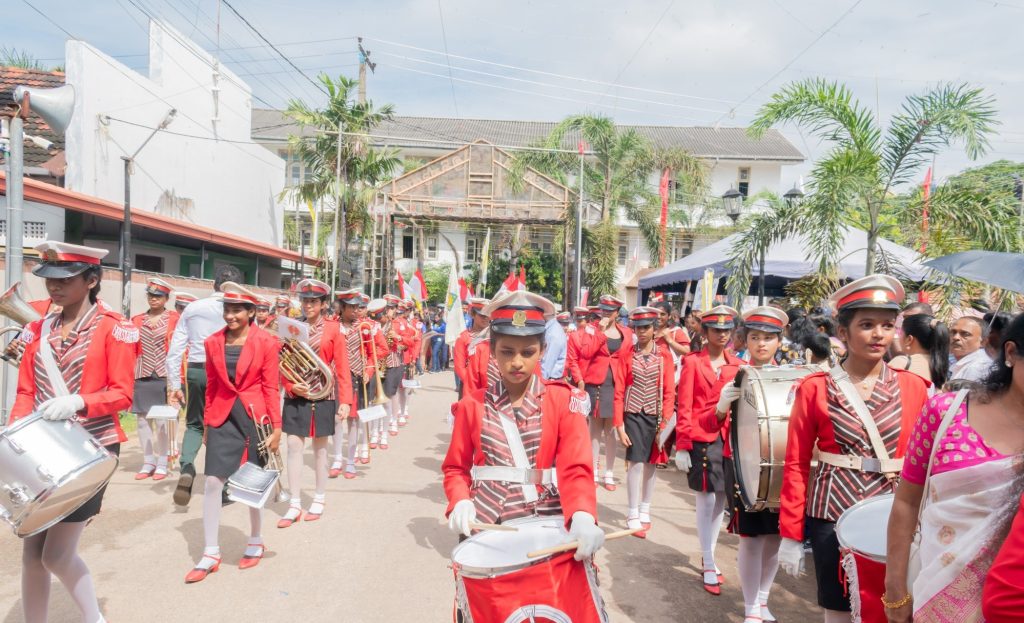
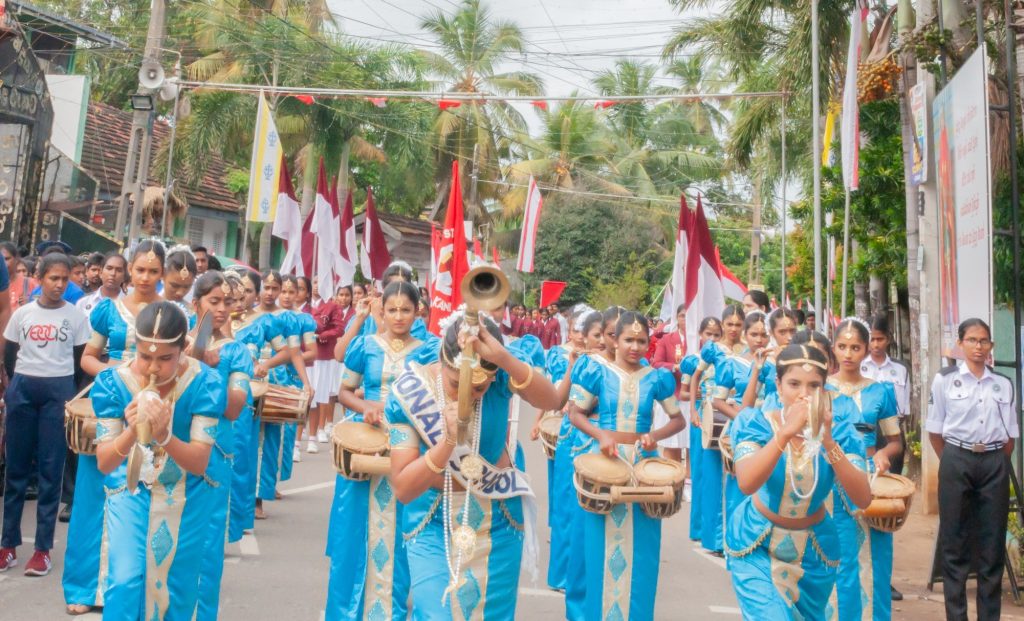
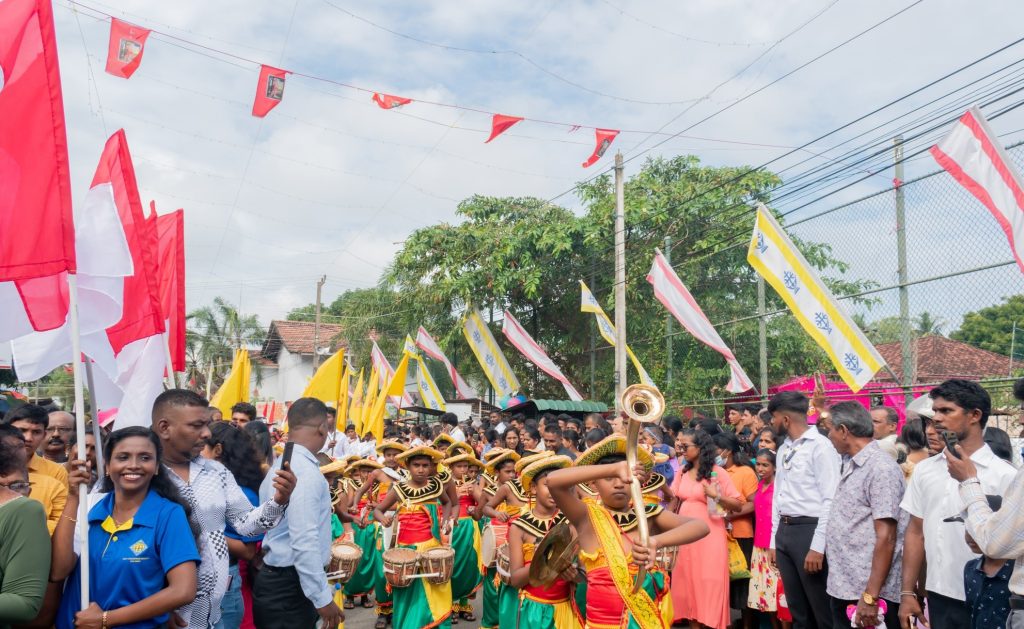
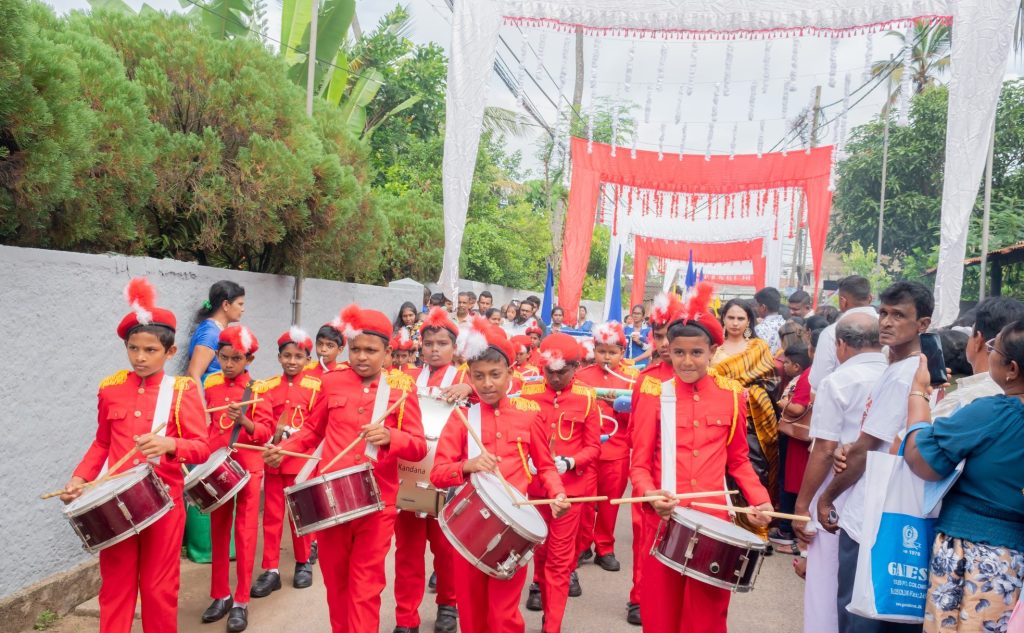
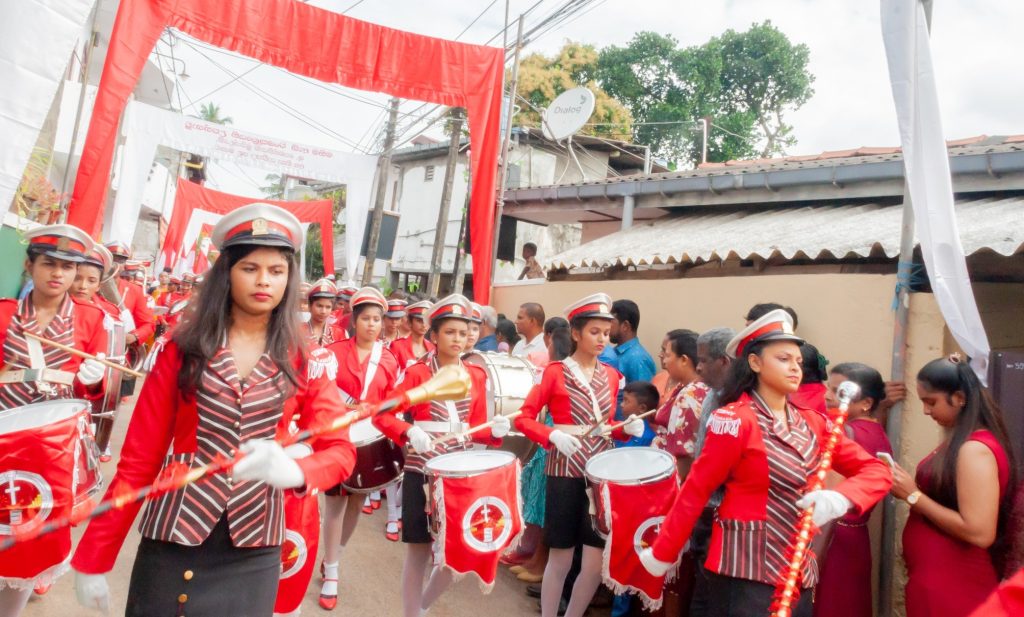
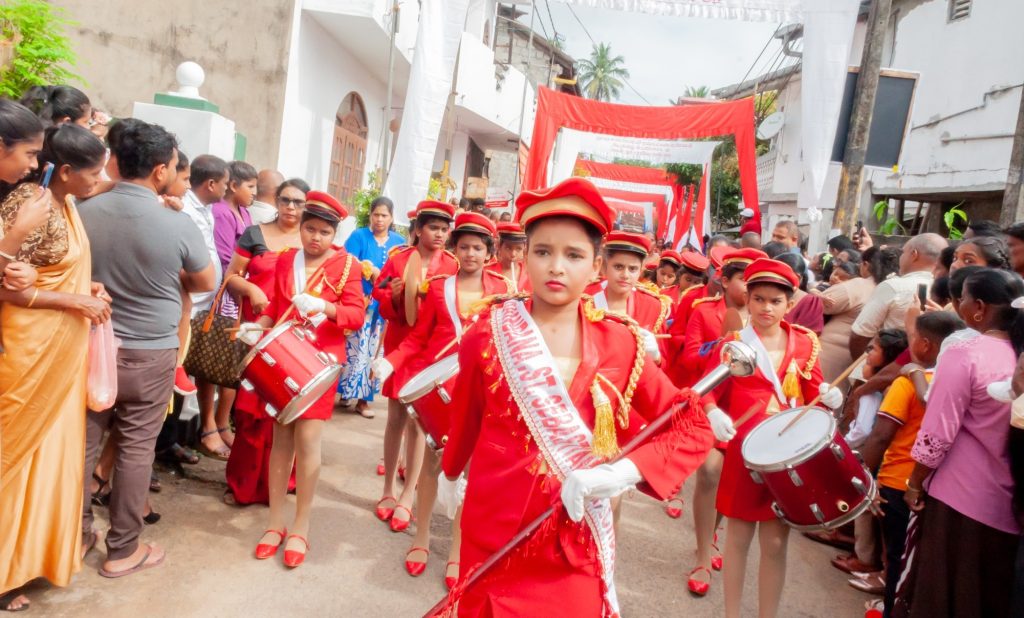
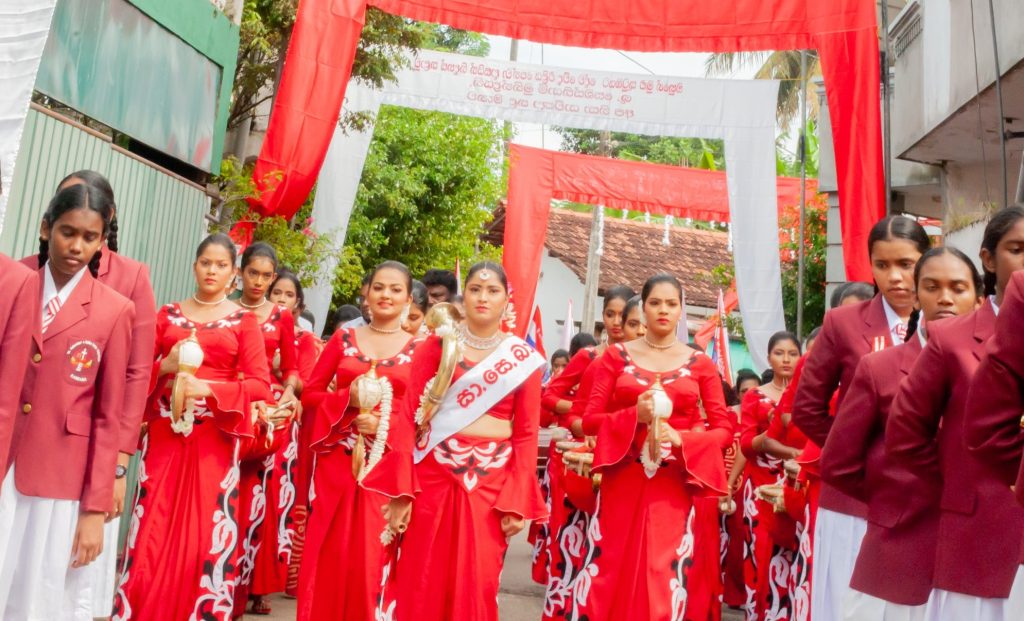
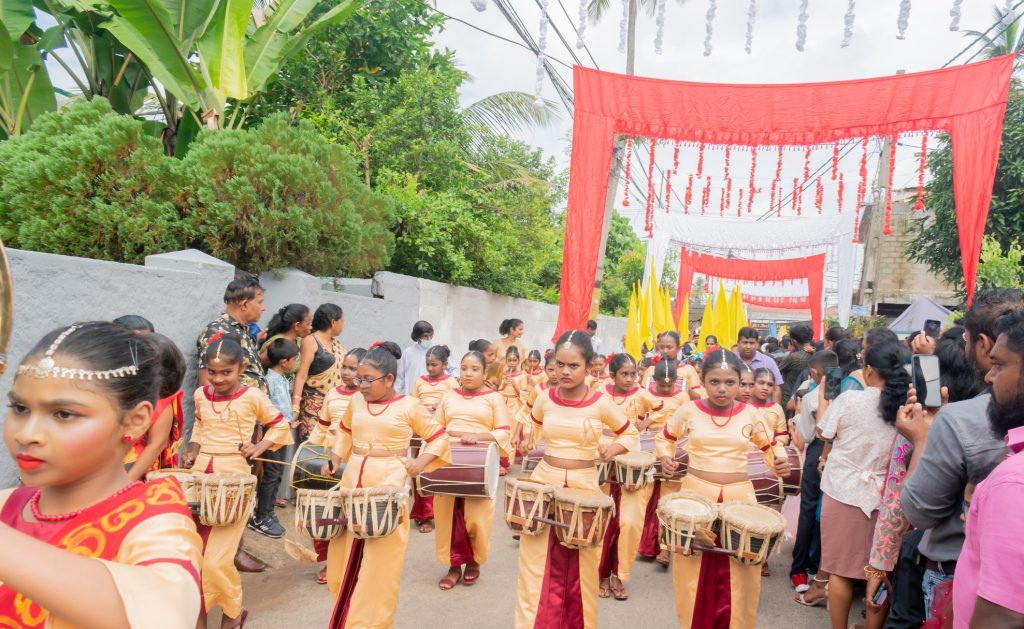
Images credit: St. Sebastian’s National Shrine Kandana Media Circle
Relic of St. Sebastian came to Sri Lanka
A relic from the arm of St. Sebastian was brought to Sri Lanka and enshrined at St. Sebastian’s Shrine, Kandana, in a specially constructed shrine room in honour of the Saint from Narbonne, who is rightly considered a role model of a Christian, ready to sacrifice everything, including his life, and die for Christ. The relic arrived in Sri Lanka on Sunday, December 12, 2014. Rev. Fr. Patrick Perera, Episcopal Vicar Negombo Region, and Rev. Fr. Shanthikumar Weliwita, Episcopal Vicar Jaela Region, presented at the Katunayake International Airport to accept the Relic. Thereafter, a service was held at the VIP Lounge of the airport.
After the service, the relic was taken in procession along the main road to St. Sebastian’s Shrine, Kandana. The procession made several stops in the parishes of Katunayake, Liyanagemulla, Seeduwa, Dehiyagatha, Jaela, Weligampitiya, and Rilaulla. At the Kandana Junction, there was a special ceremony where the Archbishop of Colombo, His Eminence Malcolm Cardinal Ranjith, was presented. From there, the relic was taken in procession to St. Sebastian’s Shrine, where the Holy Mass was conducted with His Eminence as the Chief Celebrant. The Relic is a gift from the Chief Administrator of the Basilica of St. Anthony in Padua, Msgr. Enso Poiyana, who had received the Relic from Narbonne.
Reference(s): Messenger
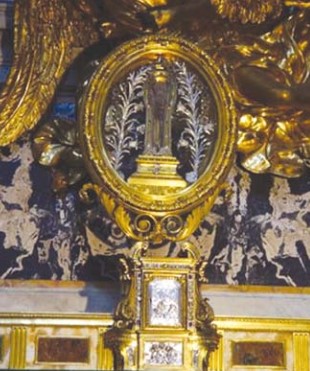
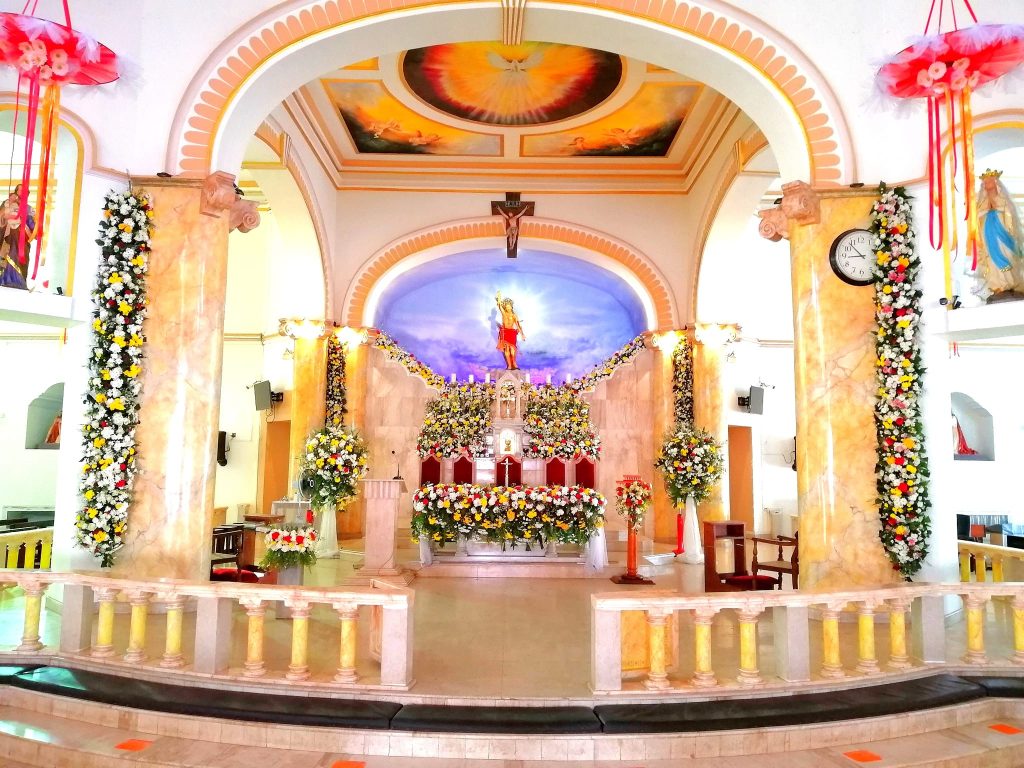

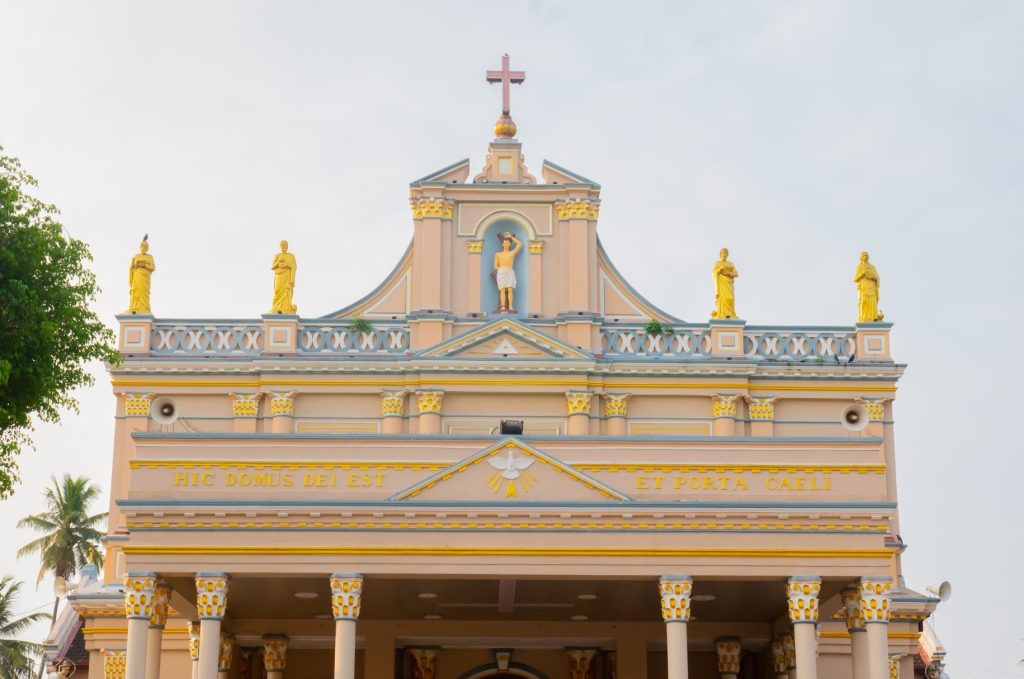
Reference(s): Sunday Observer | divaina.lk | Daily News | silumina.lk | Wikipedia | Messenger
Affiliate Disclosure: As an Amazon Associate, I earn from qualifying purchases. This blog post may contain other affiliate links as well by which I earn commissions at no extra cost to you.

